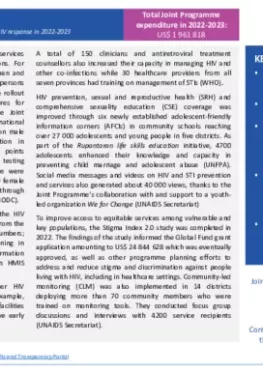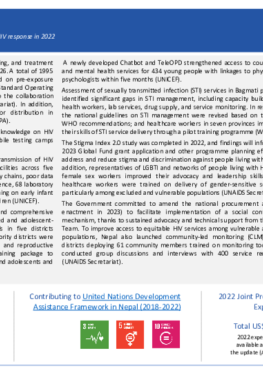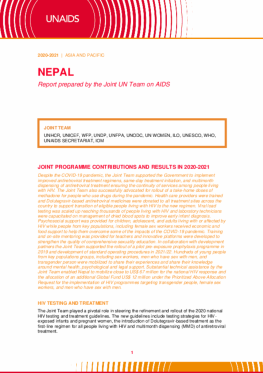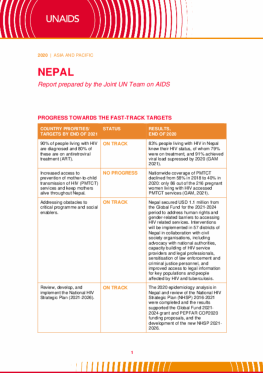|
Nepal
Nepal made encouraging progress in scaling up HIV services and education among vulnerable and key populations. For instance, more than 3100 female sex workers, gay men and other men who have sex with men and transgender persons accessed pre-exposure prophylaxis (PrEP) following the rollout of the new National Standard Operating Procedures for Implementation of Oral HIV PrEP, thanks to the Joint Programme’s collaboration with Family Health International 360 (WHO, UNAIDS Secretariat). More than 8.3 million male condoms were also procured for free distribution in government- and community-led service delivery points (UNFPA). Besides, 600 female prisoners accessed HIV testing and referral services and those who tested positive were subsequently enrolled in treatment. An additional 600 female inmates also received harm reduction education through several sessions supported by the Joint Programme (UNODC).
Several studies strengthened strategic evidence for the HIV response in Nepal. For instance, the analyses of data from the national STI surveillance system revealed rising case numbers; data gaps in congenital syphilis and syphilis screening in antenatal care in the national health management information system (HMIS); and underreporting of STI cases in HMIS (WHO).
Healthcare professionals were equipped to deliver HIV prevention, treatment and laboratory services. For example, 68 laboratory technicians in government healthcare facilities received training on early infant diagnosis to improve early detection among HIV-exposed children (UNICEF). A total of 150 clinicians and antiretroviral treatment counsellors also increased their capacity in managing HIV and other co-infections while 30 healthcare providers from all seven provinces had training on management of STIs (WHO).
HIV prevention, sexual and reproductive health (SRH) and comprehensive sexuality education (CSE) coverage was improved through six newly established adolescent-friendly information corners (AFCIs) in community schools reaching over 27 000 adolescents and young people in five districts. As part of the Rupantaran life skills education initiative, 4700 adolescents enhanced their knowledge and capacity in preventing child marriage and adolescent abuse (UNFPA). Social media messages and videos on HIV and STI prevention and services also generated about 40 000 views, thanks to the Joint Programme’s collaboration with and support to a youth-led organization We for Change (UNAIDS Secretariat)
To improve access to equitable services among vulnerable and key populations, the Stigma Index 2.0 study was completed in 2022. The findings of the study informed the Global Fund grant application amounting to US$ 24 844 628 which was eventually approved, as well as other programme planning efforts to address and reduce stigma and discrimination against people living with HIV, including in healthcare settings. Community-led monitoring (CLM) was also implemented in 14 districts deploying more than 70 community members who were trained on monitoring tools. They conducted focus group discussions and interviews with 4200 service recipients (UNAIDS Secretariat).





